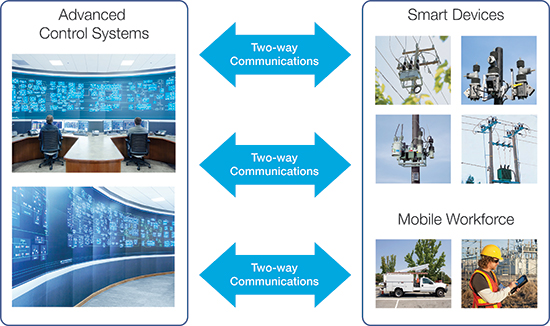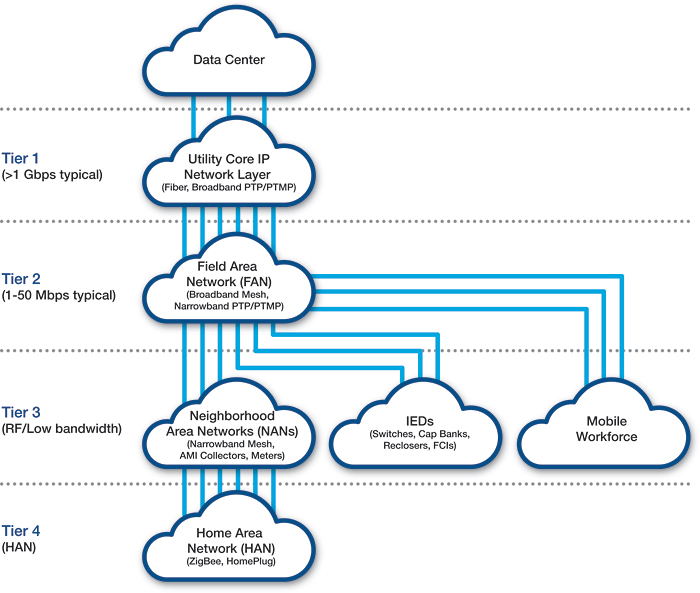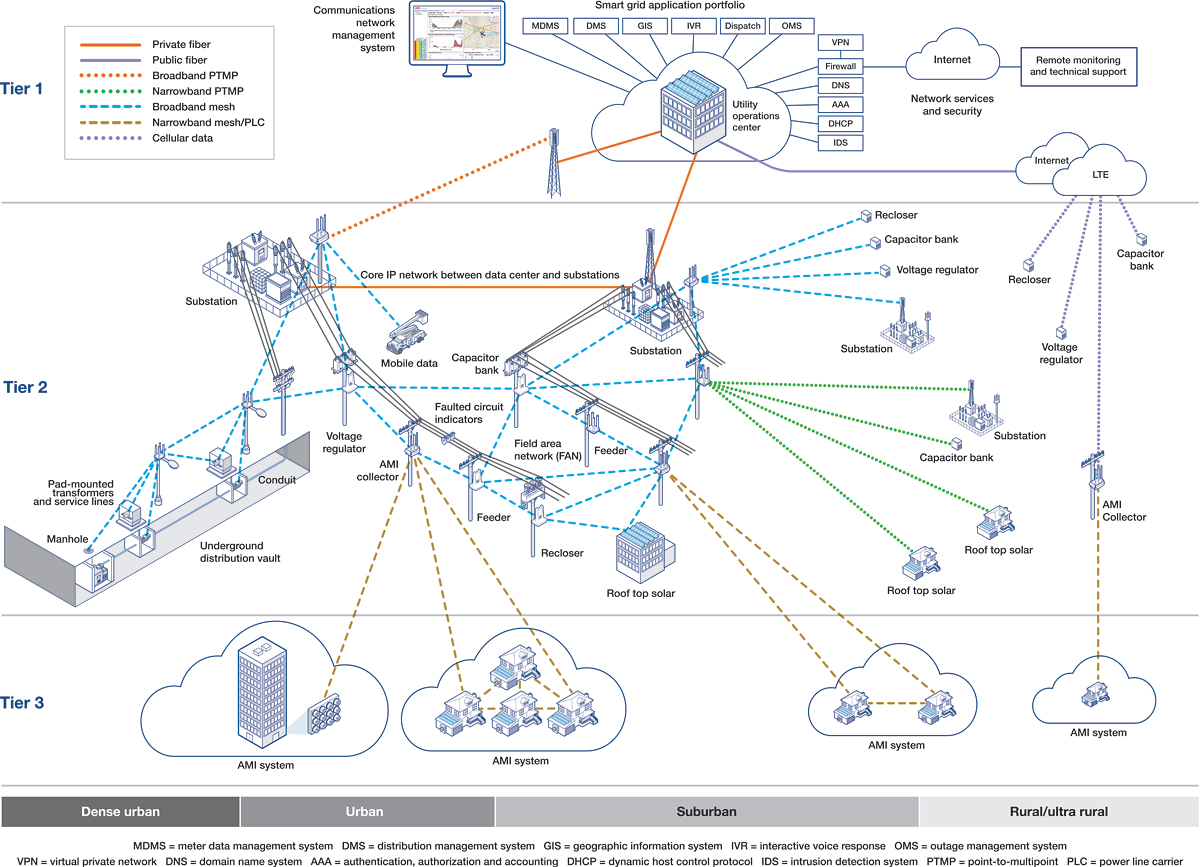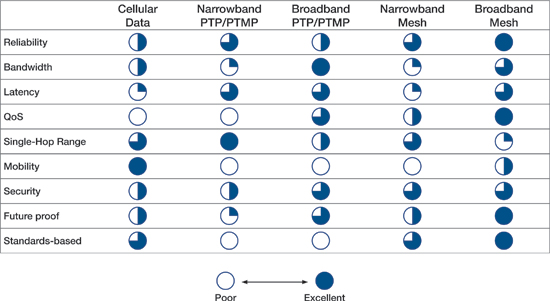To reap the reliability, efficiency, security and customer satisfaction benefits of building a smarter grid, electric utilities are deploying smart meters, intelligent electronic devices (IEDs) and other digital apparatus along distribution feeders and in substations. Electric utilities are also equipping field workers with laptop, tablet and handheld computers. Coupling these field devices with specialized computers and software in substations, plus enterprise software applications in utility data centers is a sound business and technical strategy. Why? Because it enables the operation of valuable utility applications such as automated metering infrastructure (AMI), substation automation, distribution automation, outage management, and automatic load shedding. This coupling also facilitates the ability to manage alternative energy sources.
While devices and application software get the bulk of the publicity, an oft-overlooked element – two-way communication – is required to make the smart grid smart. As shown in Figure 1, two-way communication enables intelligent devices in the field to provide data to applications running on computers in substations and data centers.

Figure 1 – Two-way Communication.
Because electric utility distribution grids can cover vast areas, wireless field communication networks are often the only technically and economically feasible choice. But wireless comes in a wide variety of flavors – broadband mesh, narrowband mesh, broadband point-to-point (PTP) and point-to-multipoint (PTMP), narrowband PTP/PTMP and cellular data services, to name a few. Which one is right for an electric utility’s field communication network?
The answer is that one size doesn’t fit all. It depends on various factors. These include: the number of assets to be connected to the field communication network in a given area, the requirements of applications to be run over the network, the topography of the utility’s service territory, and more. In fact, different wireless technologies may be required in different areas of the utility’s field communication network.
Utility Communication Network Architecture
To understand why one size doesn’t fit all, first consider the architecture of utility communication networks. Most utilities implement a two- to four-tier smart grid communication network architecture, depending on the specific applications they plan to deploy. Each tier places different requirements on the communication network. The tiers are defined as follows and illustrated in Figure 2.
- Tier 1: This is the utility’s core Internet Protocol network, which often connects many of its distribution substations. This tier is generally implemented with fiber. In areas where Tier 1 connectivity is required, but it’s economically or technically infeasible to deploy fiber, broadband PTP/PTMP is often used to extend the reach of the fiber network.
- Tier 2: The Field Area Network (FAN) fills the gap between the core Tier 1 networks and devices, as well as personnel, in the field. Substation automation devices, distribution automation devices, AMI collectors, and mobile workers equipped with laptops, tablets or handhelds connect to the FAN. FANs are generally implemented with a combination of broadband wireless mesh, narrowband PTP/ PTMP and cellular data links. Endpoint connections to the FAN can use wireless, wired Ethernet or serial links.
- Tier 3: The Neighborhood Area Network (NAN) includes smart meters and AMI collectors. The NAN is generally implemented using narrowband wireless mesh or cellular data. When a broadband wireless mesh network is used to implement the Tier 2 network, the AMI collectors in the Tier 3 network are generally co-located with and connect to the broadband mesh routers that form the Tier 2 network. The NAN may also provide the communications interface for the Home Area Network.
- Tier 4: The Home Area Network (HAN), is usually implemented using ZigBee™ or HomePlug™ technology. This provides connectivity to smart grid devices, applications and displays inside homes and businesses. If supported by the AMI system, HANs can connect to NANs via the smart meters deployed on the customers’ premises. Otherwise, the HAN will connect to the utility’s operations center via the internet.

Figure 2 – Typical Utility Communication Network Architecture
(click to enlarge)
Different Topography, Different Technologies
As can be seen in Figure 3, the best wireless communication technology choice varies with service area topography as well as with network tier, especially in the Tier 2 FAN.
In most areas, fiber, augmented by broadband PTP/PTMP as required, is the choice for the Tier 1 core IP network. An exception is ultra-rural areas, where the utility does not have enough assets or customers to economically justify a private broadband connection. In these cases, when coverage is available, a public carrier wireless data connection is recommended.
For the Tier 2 FAN, broadband wireless mesh offers the best reliability and performance. Broadband wireless mesh is best suited for dense urban, urban and some suburban areas where the number of utility assets and customers per square mile is high enough to make it an economical choice. In some areas, the effective range of broadband mesh communications can be extended by the use of directional antennas, as opposed to the omnidirectional antennas generally used. However, in suburban and rural areas where density of utility customers and assets is lower, broadband mesh may no longer be economical. In this case, narrowband PTP/PTMP is generally the best solution, although broadband PTP/PTMP may be deployed if more bandwidth is needed. As with the Tier 1 network, ultra-rural areas may not have enough assets or customers to economically justify a private communication network connection. If coverage is available, use of a public carrier wireless data connection is recommended.
Narrowband mesh is the technology of choice for the Tier 3 NAN in almost all cases. Even in ultra-rural areas, narrowband mesh may be economically feasible due to the longer range supported by the lower frequencies used by the technology. In rare cases, where cellular coverage is available, cellular data connections may be deployed in the meters themselves. However, it is more likely that narrowband mesh will be used to connect the meters to the AMI collector, and that the collector will be backhauled by a cellular data service. This is shown on the right-hand side of Figure 3.

Figure 3 – Recommended Implementation of Utility Communication Network Architecture Technology Fit
(click to enlarge)
Different wireless communication technologies have different strengths and weaknesses. These are summarized in the chart in Figure 4.

Figure 4 – Wireless Communication Technology Strengths and Weaknesses
Some characteristics, such as high reliability and solid security, are desirable in all networks. Other characteristics are important in some cases but not others.
For example, high bandwidth and low latency are important for Tier 1 and Tier 2 because these tiers aggregate traffic from the lower tiers. In addition, they must support the needs of even the most latency-sensitive applications. As a result, broadband technologies are a good fit at these tiers.
On the other hand, for metering applications, bandwidth and latency are less important. Therefore, narrowband mesh is a good fit for Tier 3.
When providing communications to rural and ultra-rural areas, long single-hop range is a key to economic feasibility. Thus, narrowband PTP/PTMP and cellular data are best suited for rural and ultra-rural areas. Conversely, they are less often used in dense urban and urban areas, where technologies with less single-hop range can be used to economically construct networks.
A summary of the technologies with the best fit by network tier and topography appears in Table 1:

Table 1 – Best Fit Technologies by Network Tier and Topography
(click to enlarge)
Many Technologies, One Network: The Unifying Role of Communication Network Management
With different tiers and multiple technologies spread across a large geographic area, it’s tempting for a utility to design, implement and operate many different field communication networks. This thinking can, however, lead to operational inefficiency, poor network reliability and security, or worse when, for example, it results in different networks having different security policies.
A communication network management system (NMS) can play a unifying role, providing visibility and control across the entire network, regardless of location and technology deployed. This holistic view enables utility operators to quickly pinpoint and address key health and life cycle challenges that are major sources of inefficiency and risk. Key requirements for such an NMS include providing network-wide visualization tools for fault configuration and performance management from a single console. The combination of rich data collection at the edge of the network and powerful analytics at the core deliver unprecedented visibility into network operation, simplifying management, improving operational efficiency, and accelerating problem/resolution time.
Conclusions
One size doesn’t fit all when it comes to utility field communication networks. A wide variety of wireless communication technologies are available. Utilities should use this to their advantage, deploying the best-suited technology based on factors such as network tiers, population and asset density, topography of the service territory and application requirements.
However, technologies shouldn’t mean different networks. The various technologies should be blended into a single, hybrid network. A robust, multi-technology communication network management system can unify various wireless – and wired – communication technologies into a single network with end-to-end visibility and control.
About the Author
 Bert Williams is the Director, Global Marketing for ABB Wireless and brings 30 years of experience in successfully leading the marketing organizations of networking companies. Mr. Williams was Vice President of Marketing for Tropos Networks from 2002 to 2007 and returned to the company shortly before its acquisition by ABB after working as an executive marketing consultant for four years. Prior to Tropos, Mr. Williams held senior marketing positions at Alteon WebSystems (acquired by Nortel Networks), Qualix Group, SynOptics Communications (part of Bay Networks), Synernetics and Advanced Micro Devices. Mr. Williams holds a BS with University Honors in Electrical Engineering from Carnegie Mellon and an MBA from Harvard Business School.
Bert Williams is the Director, Global Marketing for ABB Wireless and brings 30 years of experience in successfully leading the marketing organizations of networking companies. Mr. Williams was Vice President of Marketing for Tropos Networks from 2002 to 2007 and returned to the company shortly before its acquisition by ABB after working as an executive marketing consultant for four years. Prior to Tropos, Mr. Williams held senior marketing positions at Alteon WebSystems (acquired by Nortel Networks), Qualix Group, SynOptics Communications (part of Bay Networks), Synernetics and Advanced Micro Devices. Mr. Williams holds a BS with University Honors in Electrical Engineering from Carnegie Mellon and an MBA from Harvard Business School.








